You know visiting Iceland’s been on your to-do list for years, but you never find the right time. Live it up and plan a personalised trip with these irresistible adventure proposals. Heads up: it will be hard to choose only one.
Frozen lakes, steaming craters, colossal waterfalls, endless fields of lava, thermal waters, mysterious fumaroles, mountains of a thousand colours… Iceland is a surreal paradise, brimming with energy and natural beauty that invites you to disconnect and lose yourself among its glaciers, volcanoes and deserts with a backpack and a camera always at hand.
Here are five different adventures we recommend you try to explore the most surprising regions of the island of ice and fire.
Iceland Tips 1/6: Hiking In Landmannalaugar
Located in the middle of the barren Highlands of the country’s interior, the oasis of Landmannalaugar is the starting point of a popular hiking trail that takes you through some of the world’s most extraordinary landscapes. The hike’s official name is Laugavegur, which literally means “hot spring road,” but most people know it as “the Landmannalaugar hike.”
Getting to Landmannalaugar is an adventure itself. The only way to access it is via a volcanic gravel path that involves wading through various rivers. Two companies offer 4×4 bus rides there from Reykjavík and Hella: Trex Travel Experiences and Reykjavik Excursions.
The walking route between Landmannalaugar and Þórsmörk goes from north to south and is 56km long. Along the way are three shelters: Hrafntinnusker, Álftavatn and Emstrur. All three offer camping areas (for a fee) and are between 12 and 15km away from each other. Some of the fitter hikers take advantage in summer, when there are many hours of daylight, to walk two stretches in one go. It’s very important to take into account that shelters don’t offer food, and that during the high season overnight stays have to be booked months in advance. In other words, hikers have to be self-sufficient on this route, preparing their own camping equipment and all the food they’ll need throughout the journey. A more comfortable alternative is to hire the services of a company that arranges guided hikes, such as Tierras Polares, which has supply depots at every camp.
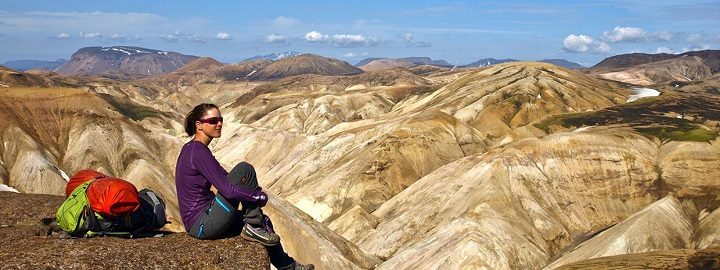
Iceland Tips 2/6: Among Glaciers And Volcanos
In the Þórsmörk valley is a little restaurant and a very basic food store, as well as shelters, camping areas and a 4×4 bus station for those who want a quick return to civilisation. Those who are still packed with energy will find another 26km hike along the spectacular route of Fimmvörðuháls, which leaves the valley behind and heads towards the Mýrdallsjokull and Eyjafjallajokull glaciers, crossing a phantasmagorical field of lava, born from the world-famous 2010 eruption. Although this last stretch is more demanding than the previous ones, the landscapes make the effort worth it from the very first slope up until the last long descent, along which we can admire a total amount of 24 sensational waterfalls.
The mythical waterfall Skógafoss will be the culmination of this unforgettable journey that can be done from June to September and is marked every summer with yellow posts. However, if the weather is bad or misty, you might not see a thing. That is why we recommend you carry a GPS device that traces the route, although you have to take into account that it may vary slightly from year to year, especially when it comes to crossing rivers.
Iceland Tips 3/6: Trekking Through The Canyon
In the northern part of the Vatnajökull National Park, a few kilometres away from the geothermal area of Krafla and lake Mývatn, the Jökulsá á Fjöllum river flows through an impressive canyon. When it reaches the Detifoss waterfall, 100 metres wide and 44 metres high, an astonishing half a million litres of meltwater thunder down every second, creating a gigantic cloud of spray that the timid rays of sunshine turn into fabulous rainbows.
The spectacular waterfall with the biggest volume of flow in Europe is well worth visiting, but once here you’ll feel the inevitable temptation to follow the waters on foot, through the Jökulsárgljúfur gorge, walking along a narrow and vertiginous path that stretches between wild waterfalls and intimidating basalt walls that looks like ghostly trolls that were turned to stone.
Discover Iceland and our cheap flights:
Until reaching the exhuberant Ásbyrgi gorge, the walk is 38km long and ideal for a two-day hike, sleeping over in the camping area at Vesturdalur, which is in the route’s midpoint. Despite being a waymarked hike, it doesn’t count with any type of service, meaning you have to carry your own food, water and clothing. There’s a 4×4 bus that connects the starting and ending points with Mývatn.
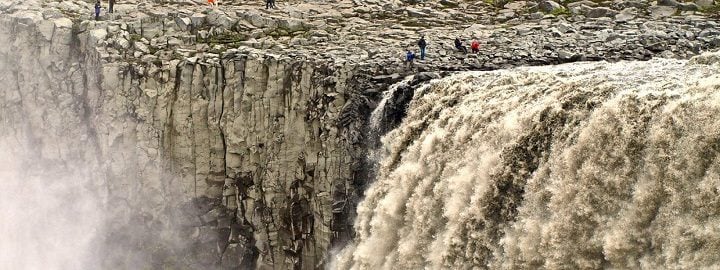
Half a million litres of water thunder down the Deitfoss waterfall every second.
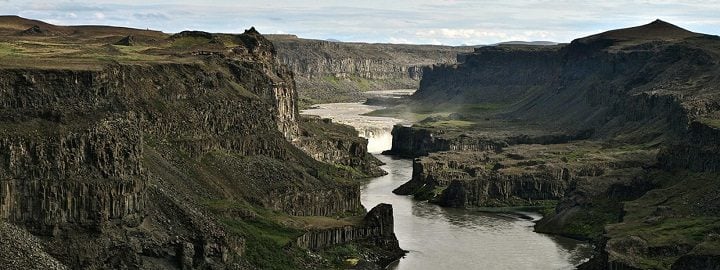
The gorges of Jökulsárgljúfur are a route that can be covered in two days.
Iceland Tips 4/6: Swim In A Volcano
Askja’s inhospitable crater is without a doubt the true heart of the Icelandic Highlands. It’s amazing to think that this barren area was formed only 140 years ago in the wake of a dreadful pyroclastic explosion that catapulted rocks all the way to continental Europe and poisoned the north of the country’s livestock with its ashes, forcing many Icelanders to emigrate to the American continent.
To reach Askja you have to follow the F88 along the western bank of the river Jökulsá á Fjöllum, which overflows every once in a while, partially submerging the road. During the summer, there’s a 4×4 bus that drives you from lake Mývatn to Dreki’s shelter, passing by the beautiful and easily recognisable mount Herðubreið, known by Icelanders as the “King of the Mountains.”
In Dreki you’ll find the beginning of a marked 9km one-way trail that goes through a highly photogenic volcanic area. The walk ends on the shores of a gigantic sapphire-coloured lake: Öskjuvatn. Some metres away lies the flooded crater of Viti. You can take a swim in its white sulphuric waters; the temperature is usually about 22ºC. If you travel by bus, you can go and come back in less than 24h, but you’ll find camping areas both in Dreki and in the oasis of Herðubreið in case you want to further explore the surrounding area.
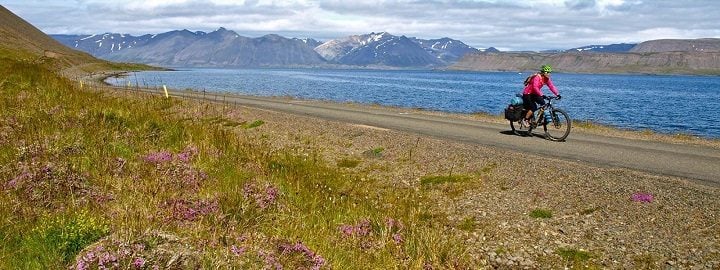
Look for your Iceland Deal now:
Iceland Tips 5/6: Pedal Along The Westfjords
Except the country’s desert interior, the Westfjords are the most isolated, solitary and inaccessible part of Iceland. The area’s bad reputation is due to its unforgiving weather, even in summer, and great number of unpaved roads. This all bestows these lands with an almost mystical aura that keeps them free from overcrowding, although it’s hard to know for how long. That is why, just like two decades ago the panoramic Ring Road was a touring cyclist’s paradise, now it’s time for the winding roads of the rough and rugged Westfjords coast to bask in the limelight.
Cycling through these latitudes guarantees almost empty roads and full contact with nature. To plan a cycling route we highly recommend you visit the state’s official roads website Road.is and, of course, the national weather service Vedur.is.
To reach the Westfjords, it can be a good idea to start pedalling in Borgarnes, which can be reached by bus from Reykjavík. You can start by crossing the Snaefellsness peninsula to then take a ferry from Stykkishólmsbær to Flókalundur, stopping over on the small isle of Flatey. Once you’ve reached the Westfjords, the route invites you to continue towards the cliffs of Látrabjarg, Europe’s westernmost point, where we can observe a colony of friendly puffins up close. We then keep skirting the coast to make our way to Bíldudalur and Hrafnseyri, stopping at hot springs such as Reykjafjarðarlaug and the spectacular Dynjandi waterfall. The path then takes us to Ísafjördur – the region’s capital –, the seal colony at Litlibaer and the thermal peninsula of Reykjanes. The route that crosses the Westfjords ends in Staðarskáli, a service area of the Ring Road where you can take the bus back to Reykjavík.
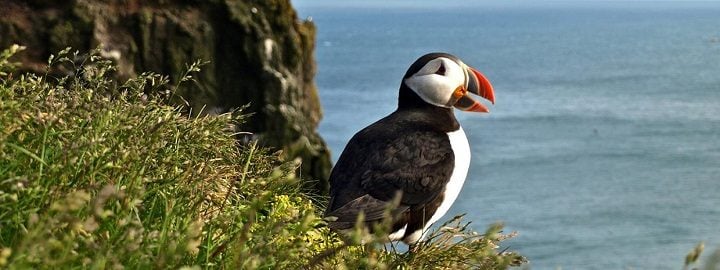
Puffins can be seen in Hornstrandir, but also in Látrabjarg.
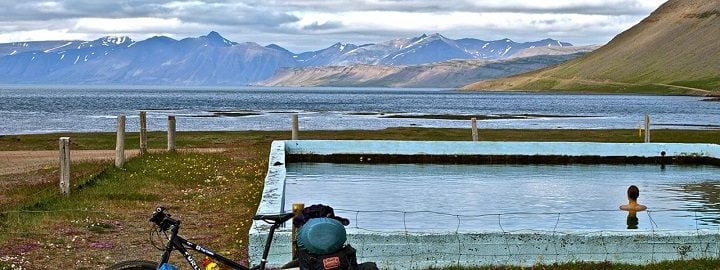
Thermal pool in Reykjafjarðarlaug.
Iceland Tips 6/6: Arctic Foxes In The Hornstrandir Natural Reserve
Nobody lives there except for forest rangers, birds and arctic foxes. The Hornstrandir peninsula can only be reached by boat and is the northernmost point of the Westfjords, as well as the most isolated and barren point of this remote region. Beyond the port of Hesteyri – where you can sleep over at the old doctor’s house, built in 1901 – there are no shops, restaurants or hotels. Only basic camping areas. Therefore, the Hornstrandir Natural Reserve is exclusive to nature lovers who are used to outdoor life and the whims of arctic weather. Some agencies, such as West Tours, organise guided hiking tours that last 4 or 5 days.
More information: Visit Iceland.



